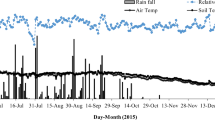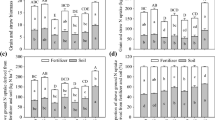Summary
Results of a two year study on the fate on15N-labelled urea (9.95 atoms percent excess15N) applied @ 180 kg N/ha to flooded rice in monolith lysimeters at the Punjab Agricultural University Farm, Ludhiana are reported. The soil of the experimental field was sandy clay loam in texture (Typic Ustochrept), had pH 7.9, organic carbon 0.36 percent, available N 187 kg/ha and total N 0.08 percent. The results revealed that 18.1 to 53.0 per cent of the fertilizer N was utilized by the rice plant, 25.1 to 41.1 percent was immobilized in the soil and 4.8 to 7.2 percent was lost by denitrification. The losses due to ammonia volatilization and leaching were negligible. The data on vertical distribution of labelled N in the soil profile reflected a higher concentration (38.3 to 39.5 per cent) in the surface (0–30 cm) soil. The content sharply decreased (1.8 to 2.4, percent) in lower soil layers (30–150 cm). A balance sheet of the various pathways of applied N showed that 58.8 to 72.2 and 66.2 to 83.0 percent N was recovered in 1976 and 1977, respectively and 17 to 41.2 per cent of labelled N still remained unaccounted for. Utilization of fertilizer N by rice was increased and losses decreased when N was applied in three equal splits as compared to the single N application at transplanting.
Availability of fertilizer N immobilized in the soil was investigated in the succeeding crops of wheat and rice. The results showed that 2.1 tot 3.4 per cent of the N applied to the preceding rice was utilized by the second rice crop grown in succession. This may look small but cannot be neglected on a long term basis. But there is need to initiate long term studies to investigate the, turnover of residual N and to determine the fate of applied N in varying soil and cropping systems by using improved techniques.
Similar content being viewed by others
References
Allen S E and Terman C L 1978 Yield and protein content of rice as affected by rate, source, method and time of applied N. Agron. J. 70, 238–242.
Bartholomew W V 1965 Mineralization and immobilization in the decomposition of plant and animal residues.In Soil Nitrogen pp 285–306. Eds W V Bartholomew and F E Clark. Am. Soc. Agron. Madison, Wisconsin.
Bremner J M 1965 Total nitrogen.In Methods of Soil Analysis Part 2. pp 1149–1176. Eds. C A Black et al. Am. Soc. Agron., Madison, Wisconsin.
Bremner J M 1965 Isotope ratio analysis of nitrogen in15N tracer investigation.In Method of Soil Analysis Part. 2 pp 1256–1286. Eds. C A Black et al. Am. Soc. Agron. Madison, Wisconsin.
Broadbent F E and Nakashima T N 1970 Nitrogen immobilization in flooded soils. Soil Sci. Soc. Am. Proc. 54, 218–221.
Boreshart H 1971 The rate of nitrogen fertilizer in flooded rice soils.In Nitrogen-15 in Soil Plant Studies. Vienna, Austria, International Atomic Agency. pp. 47–54.
Deftardar S Y 1973 Urea and ammonium nitrate fertilizers for low land rice. Studies with 15-N tagged materials on nitrogen transformation, losses and utilization. Ph.D. Thesis, IARI, New Delhi.
Datta N P, Banerjee N K and Prasada Rao D M V 1971 A new technique for study of nitrogen balance sheet and an evaluation of nitrophosphate using 15-N under submerged conditions of growing paddy. Proc. International. Symp. Soil Fert Eval., New Delhi. 1, 631–638.
De Datta S K, Magnaya C P and Moomaw J C 1968 Efficiency of fertilizer nitrogen (15-N labelled) for flooded rice. Trans. 9th Intern. Congr. Soil Sci. 4, 67–76.
Hauck R D 1971 Quantitative estimates of nitrogen-cycle processes. Concept and review.In Nitrogen-15 in Soil-Plant Studies. Vienn, Austria. International Atomic Energy Agency, pp 65–80.
Hauck R D, Melstead S W and Yankwich P E 1958 Use of N-isotope distribution in nitrogen gas in the study of denitrication, Soil. Sci. 86, 287–291.
Kai H and Wada K 1978 Chemical and biological immobilization of nitrogen in paddy soil.In Nitrogen and Rice Manila, Philippines. Intern. Rice Res Inst.
Khind C S and Datta N P 1975 Effect of method and timing of nitrogen application, on yield and fertilizer nitrogen utilization by low and rice. J. Indian. Soc. Soil Sci. 23, 442–446.
Koshino, M 1973 Incoming and outgoing of fertilizer nutrients in crops lands. I. Proc. of the Intern. Congr. on the Human Environment, HESC Organizing Committee Science Council of Japan, pp 206–214.
Manguiat I J and Broadbent F E 1977 Recoveries of tagged N (15-N labelled) under some management practices for low land rice. Philipp. Agric. 60, 367–377.
Maguiat U J and Yoshida T 1973 Nitrogen transformation of ammonium sulphate and alanine in submerged Maahas clay. Soil. Sci. Pl. Nutr. 19, 95–102.
McGill W B and Paul E A 1976 Fractionation of soil and15N nitrogen to separate the organic and clay interactions of immobilized N. Can. J. Soil Sci. 56, 203–212.
Meelu O P, Gill H S and Maskina M S 1980 Substitution of nitrogen through organic manures. Prog. Fmg. 16, 13.
Meelu O P 1980 Personal Communication.
Mikkelsen D S, De Datta S K and Obcemea W N 1978 Ammonia volatilization losses from flooded rice soils. Soil Sci. Soc. Am. J. 42, 725–730.
Oza A M and Subbiah B V 1980 Utilization of fertilizer nitrogen and its distribution in the soil profile under a multiple cropping system. J. Indian. Soc. Soil. Sci. 28, 85–90.
Patnaik S N 1965 Tracer studies on the transformation of applied nitrogen in submerged rice soils. Proc. Indian Acad. Sci. Sect B 61, 25–30.
Patnaik S M, Rao V and Nanda B B 1968 Some considerations of nitrogen uptake by high yielding rice varieties. Intern. Rice Comm. News. Lett. 17, 26–37.
Patrick W H Jr and Reddy K R 1976 Fate of nitrogen in a flooded rice oil. Soil Sci. Soc. Am. J. 40, 678–681.
Ponnamperuma F N 1972 The chemistry of submerged soils. Adv. Agron. 24, 29–93.
Porter L K, Viets F G Jr and Hutchinson G L 1972 Air containing nitrogen-15 ammonia; foliar absorption by corn seedlings. Science 175, 759–761.
Prasad R and DeDatta S K 1978 Increasing fertilizer efficiency in wetland rice.In Nitrogen and Rice Manila, Philippines, Intern. Rice Res. Inst.
Reddy K R and Patrick W H Jr 1976 Yield and nitrogen utilization by rice as affected by method and time of application of nitrogen. Agron. J. 68, 965–969.
Reddy K R and Patrick W H Jr 1978 Residual fertilizer N in a flooded rice soil. Soil Sci. Soc. Am. J. 42, 316–318.
Subbiah B V and Asija G L 1956 A rapid procedure for the estimation of available nitrogen in soils. Curr. Sci. 25, 259–260.
Tusneem M S and Patrick W H Jr 1971 Nitrogen transformation in waterlogged soils. Louisiana State Univ. Bull. 657 USA.
Upadhaya G S, Datta N P and Deb D L 1974 Note on the effect of selected drainage practices on yield of rice and the efficiency of nitrogen use. Indian J. Agric. Sci. 43, 888–889.
Ventura W B and Yoshida T 1977 Ammonia volatilization from a flooded tropical soil. Plant and Soil 46, 521–531.
Vlek P L G and Craswell E T 1979 Effect of nitrogen source and management on ammonia volatilization losses from flooded rice soil systems. Soil Sci. Soc. Am. J. 43, 352–358.
Vlek P L G and Stumpe J M 1978 Effect of solution chemistry and environmental conditions on ammonia volatilization losses from aqueous systems. Soil Sci. Soc. Am. J. 42, 416–421.
Yoshida T and Padre Jr B C 1975 Effect of organic matter application and water regimes on the transformation of fertilizer N in a Phillipines soil. Soil Sci. Pl. Nutr. 21, 281–292.
Yoshida T and Padre Jr B C 1977 Transformation of soil and fertilizer nitrogen in paddy soil and their availability to rice plants. Plant and Soil 47, 113–123.
Yoshino T and Dei Y 1977 Prediction of nitrogen release in paddy soils by means of the concept of effective temperature. J. Cen. Agric. Expt. Stn. Japan. 25, 1–62.
Zamyatina V B 1971 Nitrogen balance studies using15N-labelled fertilizers.In Nitrogen-15 in Soil Plant Studies, Vienna Austria. Intern. Atomic Energy Agency. pp. 33–46.
Author information
Authors and Affiliations
Rights and permissions
About this article
Cite this article
Rekhi, R.S., Meelu, O.P. & Gupta, R.K. Lysimeter studies on recovery of15N-labeled urea in wetland rice. Plant Soil 66, 57–67 (1982). https://doi.org/10.1007/BF02203403
Received:
Issue Date:
DOI: https://doi.org/10.1007/BF02203403




